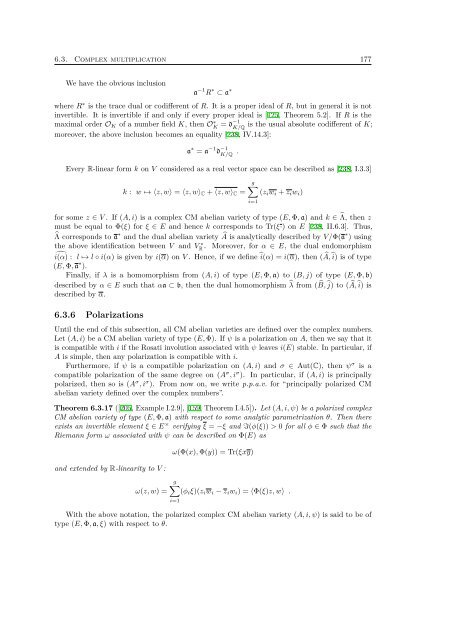here - Sites personnels de TELECOM ParisTech - Télécom ParisTech
here - Sites personnels de TELECOM ParisTech - Télécom ParisTech
here - Sites personnels de TELECOM ParisTech - Télécom ParisTech
You also want an ePaper? Increase the reach of your titles
YUMPU automatically turns print PDFs into web optimized ePapers that Google loves.
6.3. Complex multiplication 177We have the obvious inclusiona −1 R ∗ ⊂ a ∗w<strong>here</strong> R ∗ is the trace dual or codifferent of R. It is a proper i<strong>de</strong>al of R, but in general it is notinvertible. It is invertible if and only if every proper i<strong>de</strong>al is [125, Theorem 5.2]. If R is themaximal or<strong>de</strong>r O K of a number field K, then OK ∗ = d−1 K/Qis the usual absolute codifferent of K;moreover, the above inclusion becomes an equality [238, IV.14.3]:a ∗ = a −1 d −1K/Q .Every R-linear form k on V consi<strong>de</strong>red as a real vector space can be <strong>de</strong>scribed as [238, I.3.3]k : w ↦→ 〈z, w〉 = 〈z, w〉 C + 〈z, w〉 C =g∑(z i w i + z i w i )for some z ∈ V . If (A, i) is a complex CM abelian variety of type (E, Φ, a) and k ∈ ̂Λ, then zmust be equal to Φ(ξ) for ξ ∈ E and hence k corresponds to Tr(ξ·) on E [238, II.6.3]. Thus,̂Λ corresponds to a ∗ and the dual abelian variety  is analytically <strong>de</strong>scribed by V/Φ(a∗ ) usingthe above i<strong>de</strong>ntification between V and VR ∗ . Moreover, for α ∈ E, the dual endomorphismî(α) : l ↦→ l ◦ i(α) is given by i(α) on V . Hence, if we <strong>de</strong>fine î(α) = i(α), then (Â, î) is of type(E, Φ, a ∗ ).Finally, if λ is a homomorphism from (A, i) of type (E, Φ, a) to (B, j) of type (E, Φ, b)<strong>de</strong>scribed by α ∈ E such that αa ⊂ b, then the dual homomorphism ̂λ from ( ̂B, ĵ) to (Â, î) is<strong>de</strong>scribed by α.6.3.6 PolarizationsUntil the end of this subsection, all CM abelian varieties are <strong>de</strong>fined over the complex numbers.Let (A, i) be a CM abelian variety of type (E, Φ). If ψ is a polarization on A, then we say that itis compatible with i if the Rosati involution associated with ψ leaves i(E) stable. In particular, ifA is simple, then any polarization is compatible with i.Furthermore, if ψ is a compatible polarization on (A, i) and σ ∈ Aut(C), then ψ σ is acompatible polarization of the same <strong>de</strong>gree on (A σ , i σ ). In particular, if (A, i) is principallypolarized, then so is (A σ , i σ ). From now on, we write p.p.a.v. for “principally polarized CMabelian variety <strong>de</strong>fined over the complex numbers”.Theorem 6.3.17 ([205, Example I.2.9], [159, Theorem I.4.5]). Let (A, i, ψ) be a polarized complexCM abelian variety of type (E, Φ, a) with respect to some analytic parametrization θ. Then t<strong>here</strong>exists an invertible element ξ ∈ E × verifying ξ = −ξ and I(φ(ξ)) > 0 for all φ ∈ Φ such that theRiemann form ω associated with ψ can be <strong>de</strong>scribed on Φ(E) asand exten<strong>de</strong>d by R-linearity to V :ω(z, w) =i=1ω(Φ(x), Φ(y)) = Tr(ξxy)g∑(φ i ξ)(z i w i − z i w i ) = 〈Φ(ξ)z, w〉 .i=1With the above notation, the polarized complex CM abelian variety (A, i, ψ) is said to be oftype (E, Φ, a, ξ) with respect to θ.
















